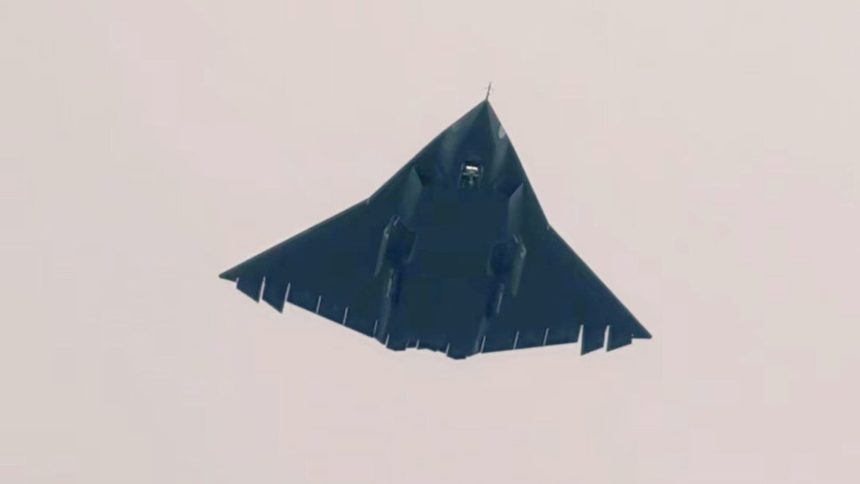China’s Mysterious J-36 Next-Gen Aircraft Spotted During Second Test Flight
Published on: March 17, 2025 at 7:53 PM
 Follow Us On Google News
Follow Us On Google News
Bottom view of the J-36/JH-XX during its second flight. (Image credit: Chinese internet)
SHARE
The next-generation J-36 appears to be still in the initial phases of flight testing, flying with landing gear down and a flight data probe installed on the nose.
One of China’s two so-called sixth generation jets, dubbed the J-36, has been
spotted flying over a city at low altitude, with analysts stating this was the aircraft’s
“second test flight”, or at least the second that we know of. The new unofficial videos and images on Chinese social media show the jet flying overhead with what appear to be simple phone cameras.
Various videos captured by people on the ground show the J-36 making a turn, while others show a decent side and bottom view, with the landing gear still extended. The aircraft also has a flight data probe (pitot tube) on the nose, further pointing to its initial testing phase, which is far from serial production and operational induction.
The jet
first emerged online on Dec. 26, 2024, flying from the Chengdu Aircraft Corporation (CAC) headquarters, with
another futuristic design captured in ground footage from the Shenyang Aircraft Corporation (SAC) the same day. Rumored to be the J-XX fighter, it is not clear if this was another 5th generation or a 6th generation aircraft, meant to complement the J-36. The first aircraft was accompanied by a
twin-seater J-20S, while the second airframe was chased by a Chinese-made Flanker-derivative – either a J-11 or a J-16.
As we mentioned in earlier reports here at
The Aviationist, at this stage it is impossible to verify the Chinese claims about these designs being 6th generation aircraft. Also, the description of 6th generation itself is still being debated, as they are often seen as multirole assets, air superiority assets, “
quarterbacks” of the attack force, depending on who you ask.
One
image, sourced from Chinese social media and shared on X by leading Chinese military aviation analyst Andreas Rupprecht, showed a rear-aspect view of the J-36, showing bright exhausts, similar to afterburners, from its three engine nozzles. Rupprecht, however, clarified that it was not clear if this particular image was legitimate or if it was doctored.
Existing and verified images of the J-36, which emerged since it was first reported, showed the aircraft being seemingly equipped with three flat nozzles, while this showed a roundish outlet. Possibly, this could be because of the powerful exhausts spreading outside either the flat nozzles or variable geometry nozzles.
The J-36 has two engine intakes under the wings, on the sides of the fuselage, and one dorsally-mounted intake behind the cockpit. The aircraft has a tailless, flying-wing configuration, with a twin-wheel nose landing gear, and tandem-wheeled main landing gears, like the
Su-34 Fullback fighter-bomber.
Also, in the space between the two landing gears on the underbelly, the J-36 could house internal weapons bays for large long-range surface strike missiles. In the future, we might see them fully open, revealing their payload capacity and housing design, the same way the
J-20’s weapon bays opened their doors for the first time to viewers during the 2018 edition of the Zhuhai Air Show.
The J-36’s latest side-aspect view also shows what appears to be a black and gray camouflage paint scheme. The bottom and rear view shots of the latest set of images show its split trailing edge control surfaces, both in the open and closed position, which act as air brakes, used to increase drag and slow down the aircraft. These air brakes and paint scheme were also clearly visible in the J-36’s Dec. 2024 revelation.
The J-36’s smooth design also suggests that it has a certain level of optimization for both aerodynamic efficiency and low visibility, leading to higher speed, and thus higher kinetic energy, that can be provided to missiles when launched, and a reduction of the chances of being tracked by anti-air radars and air-to-air missiles. Maneuverability and stability might be achieved by advanced flight control software and a new-generation of control laws algorithms.
So far, there have been no graphic renditioned videos of either the J-36/JH-XX or the J-XX on official platforms like
CGTN,
CCTV or military media wing, giving insight into how the aircraft is envisioned to perform. Generally, the official state outlets are believed to reflect the thinking of the PLA’s military planners or its aerospace industry.
Engines
The first aircraft – that assessments have mentioned could be a “regional bomber” with elementary capabilities of the under-development H-20 strategic bomber- was also designated as the JH-XX at the time. One post said the aircraft is powered by either the WS-10C turbofan engine or the supercruise-capable
WS-15, meant to power all future production variants of the J-20 stealth fighter.
The WS-15 is believed to be the Chinese equivalent to the Pratt and Whitney F135 that powers the F-35 series of jets, or the Russian Saturn AL-41F1S turbofans that powers the
Su-35S. The make of the JH-XX/J-36’s engines is however speculative at best, but it can be assumed that Chinese engineers would be working on
adaptive cycle engines, similar to the U.S. industry’s efforts to have the next-generation power plant for its NGAD (Next-Generation Air Dominance Program).
Adaptive cycle engines are considered to be a step even above the FADEC (Full Authority Digital Engine Control) system, capable of automatic engine thrust and fuel-burn adjustments at different flight stages, speeds and altitudes.

 brandequity.economictimes.indiatimes.com
brandequity.economictimes.indiatimes.com












































